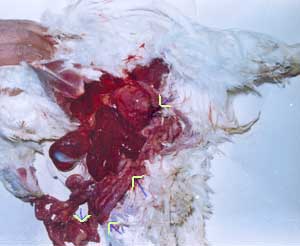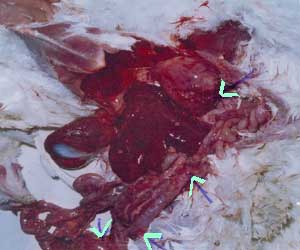 |
|
||||||||||
|
|
 |
|
|||||||||
|
|
|
 |
|
||||||||
|
|
|
||||||||||
|
|
|
||||||||||
|
|
|
||||||||||
|
|
|
||||||||||
|
|
|
||||||||||
|
2006, Vol 1 No 2, Article 7 Clinical Study on Hjarre's Disease in Poultry
Shah, K. A. and Qureshi, S. INTRODUCTION
Hijarre’s Disease (Coligranuloma) is a
disease of adult chicken and turkey, characterized by nodular granulomas
in liver, mesentery and walls of intestine. It is caused by Escherichia
Coli, a gram -ve , non-acid fast non-spore forming bacillus. Besides
coligranuloma, E-coli has more oftenly been incriminated in number of
other clinical conditions which include coli bacillosis, coli septicemia,
egg peritonitis, arthritis and air saculitis etc. causing decrease in
production high mortality rate and condemnation of carcass at slaughter,
thereby resulting in major economic losses to the poultry Industry. MATERIALS AND METHODS Occurrence of sudden sporadic deaths among adult stock in an organized poultry farm farmed basis for this study. The affected flock was dull, depressed and anorectic, reared on deep litter and had been already vaccinated against new castle disease, Infectious bursal disease and Marek’s disease as well. In order to elucidate cause of mortality, thorough necropsy examination of fresh carcasses was conducted. Morbid material was aseptically collected and subject to culture sensitivity test. Tissue smears were prepared by crushing individual nodules between two glass slides (Randall 1991) and stained with Ziehl-Neelsen staining method (Zahoor 2003). RESULTS AND DISCUSSIONS Pathological lessions detected at necropsy were pathognomic for coli granuloma. These included, coagulation necrosis and enlargement of liver, hard nodular granulomas in the mesentry, walls of intestine, particularly cecum congested and swollen spleen with abnormal contours, congested viscera with atrophied bursa normal peripheral nerves and bone marrow corroborating with reports of Calneck et. al 1991, Randall 1991 and Jordan 1990.
Moreover, tissue smears prepared from nodules did not reveal
presence of any acid fast bacillus on Ziehl-Neelsen staining, thus
ruled out the possibility of Avian tuberculosis. Bacteriological
examination of morbid materials carried out in accordance to
procedures of Edward and Ewing 1972 and Cruik Shank at. al. 1975
indicated infection with Escherichia coli. Isolate was found
resistant to sulfha drugs, cephalaxine, ciprofloxacine, ampicillin
and amoxycillin and sensitive to enrofloxacin furazolidons,
sparfloxacin ofloxacin and gentamicin showing maximum zone of
inhibition for enrofloxacin and minimum for gentamicin. ACKNOWLEDGEMENT The author is highly grateful to Joint Director, and staff of Bacteriological Section Institute of Animal Health and Biological Products, Zakura for providing necessary facilities and help. REFERENCES
|
|
||||||||||
|
|
|||||||||||
|
|
|||||||||||
|
|
|||||||||||
|
|
|||||||||||
|
Copyright © Vet Scan 2005-2006 All Right Reserved with VetScan and
www.kashvet.org |
|
||||||||||
| Home | e-Learning |Resources | Alumni | Bird Flu | Forums | Disclaimer |
|
||||||||||
|
|
|
|
|
|
|
|
|
|
|
|
|

